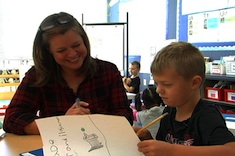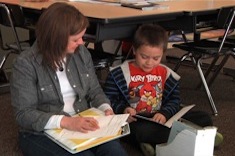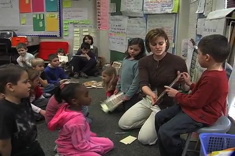I was scurrying around to a few students whom I had a hunch would benefit from a few books I’d selected—high interest but also decodable—from my “little” library. I slid in next to Vanessa. “I can’t read words,” she said when I showed her that I had brought her some books.
“That’s okay,” I said. “We’ll read them together.”
As we worked our way through the first one, she looked up at the word wall when she came to the word are. She read it and continued on. She finished the book and looked at me with twinkly eyes and, I assume, a smile behind the mask.
“How did you remember to get help from the word wall when you came to are?” I asked.
“Because you put it in two places—under /a/ for the first letter and under /r/ for the first sound. So I just remembered it was there!”
Vanessa eagerly grabbed the next book and again, read through the repetitive text while needing very little help. She talked her way through the story, making connections, sharing stories about reading at home, and laughing at the pictures. As reading time ended, she asked if I had any other little books and when she could read next. I assured her we would find time.
When I picked up the class after recess, she asked again about more reading time. Her excitement for reading was bubbling up over her mask and into other subject areas when she added, “I can’t wait for writing time today, and I don’t even like writing!”
I commented on her positive learning energy, and she laughed. “I know—I’m just like you now!”
Later that afternoon I chuckled to myself about Vanessa’s energy and everything she had done and said. Before the start of school it was shared with me that Vanessa had a sharp tongue and that I should seat her away from a few specific other students. It’s true that Vanessa is energetic, vocal, and needs some behavior reminders, but she’s also engaged in our class learning . . . She listens, participates in lessons, is very social, and is transferring her learning to the tasks she is working on. I think what makes me the most joyful is the level of effort she puts in. She is trying her best.
As I reflected on Vanessa’s energy, I was curious to pinpoint classroom elements that are supporting her and encouraging her learning joy. The beginning structures of workshop teaching stood out:
- Regular conferences: From the first week of school, I’m meeting with students to get to know them as readers and as learners. I find out what interests them and what their skills are, and build connections between the two of us. From our first conference I knew that Vanessa lacked reading confidence and had already labeled herself a poor reader. I also knew that she was eager for instruction and excited for “learning books,” books that she could decode successfully.
- Library access: The main part of my library was open to students as soon as I could teach the functional part of the library, i.e., how it works to get books and return them. Vanessa was quick to choose lots of books—her excitement for books was overflowing, and having a big assortment to choose from created a lot of joy for her. I added extra books that I suspected would match her interests and encourage reading practice. I included them in her stack right at the beginning!
- Independent practice: I started lessons right away that would help students gain independence in their reading and writing. Lessons in sound spelling, embracing a few sight words, learning to read and write each other’s names, and numerous read alouds give students entry points to independence and especially to voice and choice.
Throughout the day Vanessa has choice in her reading and writing, regular interaction with her peers and me, formative assessment that guides what I ask her to do, minilessons that are designed with the class in mind, and lots of time for independent practice. These basics of workshop reach all students to encourage lifelong literacy skills and, most importantly, learning joy.









